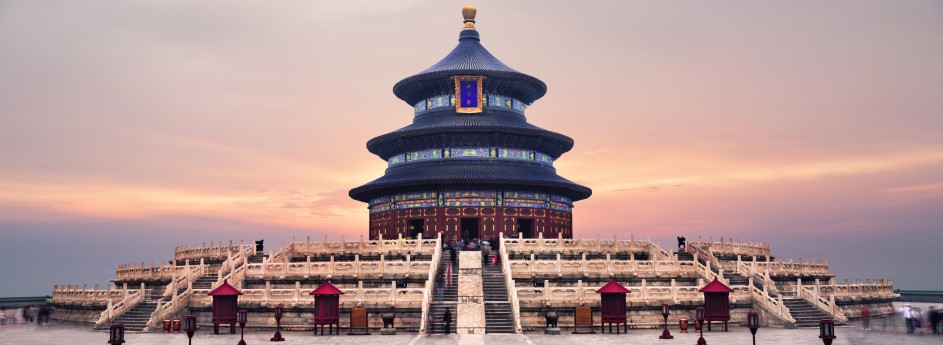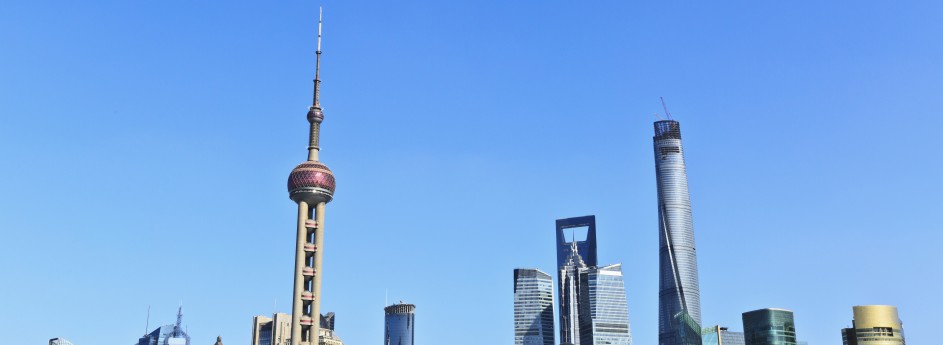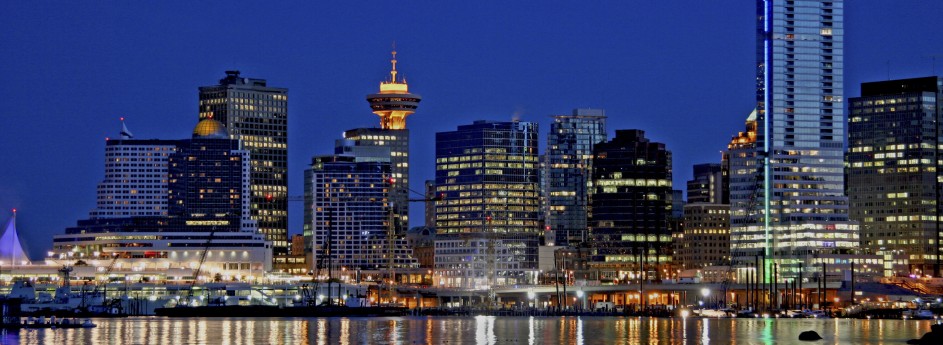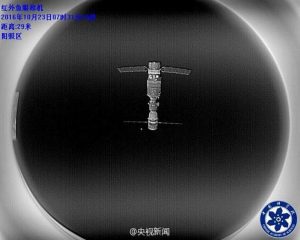Tiangong II’s ‘Selfie Satellite’
Here’s a great new view of China’s Tiangong II space station, taken by a new ‘selfie’ satellite. The Banxing-2 satellite is about the size of a desktop printer and was released from the station on Sunday. It has been nicknamed the “Selfie Stick” by Chinese officials and is taking pictures of the station and the docked Shenzhou XI spacecraft. The Chinese astronauts who boarded the station last week aren’t just joining the selfie craze; the 25 megapixel camera with wide-angle and infrared imagers has a specific job. “The companion satellite monitors the conditions of Tiangong II and Shenzhou XI all the time, which is helpful in detecting failures,” said Chen Hongyu, chief engineer of the micro-satellite.
– Universe Today
Duterte’s Pivot to China and Sino-US Rivalry

President Rodrigo Roa Duterte and People’s Republic of China President Xi Jinping shake hands to conclude a successful bilateral meeting at the Great Hall of the People in Beijing on October 20. Photo by Toto Lozano/PPD
Philippines President Rodrigo Duterte’s reversal of the confrontational ways of his predecessor toward China has prompted much soul-searching and second-guessing in Washington’s halls of power and at the headquarters of major Western, especially American, media organizations. Indeed, Time magazine deemed Duterte’s statement about a “separation” from the US “stunning”, adding that under the backdrop of acrimonious relations between the two countries over the recent past, the setting was “momentus”. A contributor to Foreign Policy magazine stated outright that it is a “disaster” for US foreign policy.
Underpinning the US’s ‘pivot’ to Asia inaugurated by President Obama and then Secretary of State Clinton, apart from shifting 60% of its military might to Asia-Pacific, is America’s relations with longstanding allies like Japan, South Korea, Australia and Singapore. One of the pillars of that strategy is relatively unfettered access to Philippines bases from which it could seek to hem China within the so-called ‘first-island chain’ linking the Japanese archipelago, Okinawa, the Philippines and Taiwan.
Yet, Philippines foreign policy insiders say openly the Obama Administration has failed to “put meat into its declaration”, leading Duterte to suspend joint military patrols with the US in the South China Sea soon after he assumed office. This week, in a subsequent state visit to Japan after China, Mr Duterte reiterated he wanted foreign military troops (meaning US) out of his country “probably in the next two years.” Pointing to U.S. colonization for over half a century, Duterte said the Philippines will “survive” without U.S. assistance.
Over the summer, President Duterte did not take kindly to high profile criticism from President Obama, the UN, and the EU of his heavy-handed but effective war against the drug lords with the US upping the ante by refusing to sell him arms. In a CCTV interview before his departure to Beijing, Duterte complained, “some other countries know that we are short of money, (but) instead of helping us, all they had done was just to criticize. China never criticizes. They help us quietly. And I said that’s why it’s part of the sincerity of the people”.
In the Chinese capital, Duterte was handsomely rewarded for his win-win statements and reinvigorated spirit of dialogue and cooperation. In trade and investment, the Chinese side agreed to spend US$15 billion on projects to help realize what promises to be the biggest infrastructure boom in the Philippines since the bad old days of dictator Ferdinand Marcos. Much of those facilities will be built by Chinese companies, including railway lines and dredging to enlarge the Cebu International Bulk Terminal Port. Philippines will also partake in China’s One Belt, One Road initiative that involves multi-faceted connectivity along the age-old maritime Silk Road.
In the fallout of Duterte’s ‘pivot, policy makers and analysts on both sides of the Pacific inclined to seeing great power relations in zero-sum game terms are wondering whether it will trigger a ‘bandwagoning’ domino effect on smaller powers toward China or increasing their propensity to ‘balance’ or ‘hedge’ against the rising Asian superpower. The Chinese and Philippines defense ministers’ agreement to restore ties between the two navies undoubtedly called all countries with territorial disputes with China in the South China Sea to attention. Aside from Japan, which has all of its eggs in the American basket, the focus is on third-tier countries like Vietnam that, prior to Duterte’s pivot, was bonding with would-be ally the Philippines and making friendly gestures to its former arch-enemy.
However, in light of Duterte’s harsh anti-Washington rhetoric, Vietnam was already back-peddling from any fabled alliance with would-be partners. Over the summer in Beijing, its defense and foreign ministers sang the praises of time-tested Vietnam-China relations. Then, in October, just prior to Duterte’s China visit, the country hosted the first-ever batch of three Chinese frigates at its newly-opened Cam Ranh international port which during the Vietnam War had served as a strategic deep water bay for the US navy.
This is all in line with Vietnam’s stated policy of non-alignment with any camp despite the warming of relations with the US over the past couple years. Since its opening, Cam Ranh has hosted ships from several countries including, France, Japan, Singapore, and the US. Ha Hoang Hop, a Vietnamese academic with close ties to the Vietnamese authorities told Reuters, “This is actually quite normal, showing that Vietnam is open to all countries and does not take any particular side…Vietnam’s diplomatic policy is not to engage with any military ally, or engage with any country, to oppose a third country.”
Thailand’s China embrace is also somewhat disconcerting to America. The military junta has been courting China since it took power in 2014. Although Thailand is bound by a US military alliance with the US, it has commissioned China to build three submarines and enhanced military relations with China just as Washington suspended military aid over civil liberties concerns about its rule. Thailand has deported suspected Uighur Jihadists cum illegal immigrants en route to third countries and denied entry for Hong Kong “Occupy Central” protest leaders.
Moreover, as the largest trading partner of every country in East and Southeast Asia, China simply holds much sway in Thailand, heavily investing in the country since the coup and flooding its resorts with Chinese tourists. The same can be said of other ASEAN members: successful talks with Myanmar’s new government, building railways and power plants in Laos; various aid and investment projects in Cambodia; enhanced trade with Malaysia; and building high speed rail in Indonesia.
While causing much consternation among American policy makers, and contrary to some US-based pundits who vilify him as an irrational and ideological loose cannon, Duterte is above all a nationalist pursuing an independent foreign policy and looking out for the fundamental interests of his country. At a news conference in his home town early last month, Duterte declared, “in our relations with the world, the Philippines will pursue an independent foreign policy. We will observe, and must insist, I repeat, I must insist, on the time-honoured principles of sovereign equality, non-interference, and the commitment to a peaceful settlement of disputes to best serve our people and protect the interests of our country.”
This is music to Beijing’s ears and history may be in China’s favour, argued political scientist Zhang Baohui of Hong Kong’s Lingnan University. “In the long term, the balance in the region may continue to shift in China’s favour. Duterte has stated explicitly that only China “has the resources” to help the Philippines to achieve genuine economic modernization…This implies that Duterte’s China pivot is motivated in part by China’s rising material capabilities…Therefore, it is plausible that a continuously ascending China may trigger additional bandwagoning behaviour by countries in the region.”
New Book on the Rise of the Renminbi
Eswar Prasad is a renowned economist at Cornell University mentioned before on this blog and an expert on the trajectory of the renminbi (RMB). His most recent book Gaining Currency: The Rise of the Renminbi provides a vivid account of its growing influence around the world but also the challenges and obstacles that lie ahead for the ‘redback’. Its rapid rise following the global financial crisis is shown in the charts below, albeit still at very low level.
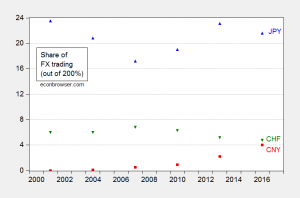
Share of OTC forex turnover accounted for by the RMB (red), the Japanese yen (blue) and the Swiss franc (green).
Mr Prasard is cautiously optimistic about the prospects of the “people’s currency” and he’s probably right that it won’t take over from the dollar anytime soon. However, in the coming decade or two, it will certainly be a strong contender for the no.2 spot, most likely displacing the euro. He also underestimates the Chinese government’s commitment to political, legal and institutional reforms and is wrong that the currency will not attain “safe haven” status for investors. If not Western investors, certainly Asian and developing world investors will want to buy RMB to hedge against crises.
The book’s website writes: Gaining Currency traces the RMB’s ascendancy from revolutionary symbol to reserve currency held by foreign central banks. Prasad reveals the interconnections linking China’s growing economic might, its expanding international influence, and the rise of its currency. If China plays its cards right by adopting reforms that put its economy and financial markets on the right track, the RMB could rival even the euro and the Japanese yen.
Prasad shows, however, that while China has successfully adopted a unique playbook for promoting the RMB, many pitfalls lie ahead for its economy and currency that could limit the RMB’s ascendance. The Chinese leadership is pursuing financial liberalization and limited market-oriented reforms…While the RMB is likely to become a significant reserve currency, it will not attain “safe haven” status as a currency to which investors turn during crises.

